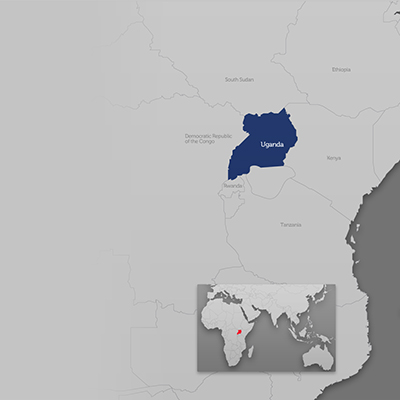
Uganda
Congolese Refugee Crisis Report
January 1, 2014
Jonathan White and Naku Charles Lwanga
The Congolese Refugee Crisis in Uganda
The recent fighting has driven an influx of more than 65,000 refugees from DRC into Uganda and the situation is abysmal. There is no water, sanitation, healthcare, shelter, or roads to support these people and all repatriation processes have been halted. The establishment of additional shelters, water sources, communal kitchens, start-up vaccination for under-five-year-olds and support to existing health centers have been ranked as urgent priorities.

The refugees are currently camping at the Bundibugyo and Kyangwali Refugee Settlement areas at Bubandi sub-county headquarter land. We have been repeatedly asked by the medical officer at the camp to continue supplying urgent medicine needed that isn’t currently being provided by other INGOs. In addition a large number of these refugees are likely to be relocated to the Kiryandongo Refugee Settlement, and specifically need the support we provide in the Panyadoli Health Center.

Our field staff assessed the main camp at Bundibugyo for health crisis issues and determined the following update on August 18th, 2013:
Doctors Without Borders (MSF), which was the lead medical partner at the Bundibugyo, will be pulling out by the middle of September to concentrate on Kyangwali because of funding shortage leaving the main clinic with a large gap in medical supplies.

These Congolese are as a whole generally not immunized, either because they were living at the extreme end of Congo where no Government health facilities are located, or the majority of people are too poor to afford the private sector clinics. They also have little to no knowledge of TB, Malaria or HIV/AIDS. Most refugees interviewed still treat themselves with traditional herb treatments. Currently every child below 5 years is being immunized at the camp.

The current camp is erected near the Bubukwang Health Centre III, and this is where any donated drugs go and treatment is carried out. Since the health centre buildings are few compared to the number of patients, tents have been erected to act as wards and medicine stores as depicted in the following.
See below for second update on Medicine Delivery and photos from October 2013.



Second visit to Bundibugyo Refugee Settlement in October 2013
Upon reaching Bundibugyo with the requested medications and supplies, everyone was very relieved to see RMF as the medical supplies were running so low. Most of the large NGOs have all withdrawn from Bundibugyo. Currently, Malteser International (German organization) is in charge of health, and UNHCR and OPM are operational at the transit center. Even the Red Cross has almost entirely withdrawn from the camp as a result of having less than 10 volunteers on the ground.

About 4,000 refugees are still on the ground and resources are very limited. Children had been overseen by Save the Children, with volunteers keeping children and youths active. Overall withdrawal of support to the camp has made the youths stay idle and redundant. Most people, especially children and youths, have no clothes at Bundibugyo. Hygiene is poor, likely due to lack of resources such as soap and sensitization training. When NGOs were present at the site, basic needs like soap, clothes, etc. were given in plenty, but now, the refugees can only rely on what Government and UNHCR have to offer.

Before their withdrawal from the camp, OPM, UNHCR, and other NGOs identified challenges and opportunities surrounding the continued provision of services:
The camp is located in a swampy, wet area. When it rains, all of the tents are prone to flooding, making it wet and very cold for those living within them, especially at night. Organizations that were working with the camp dug trenches and brought marram soil from the mountains, placing the tents above the soil, which ensures those sleeping within the tents stay warm despite the rains. When it rains heavily, the water runs into the trenches dug, helping to redirect the rain and flood waters. Heavy tanks for water have been provided, so water is supplied in all corners of the camp. Latrines have been dug throughout the camp, ensuring sanitation, although hygiene is poor.

The system has been put in place, but the challenge now is limited funding to the camp and manpower to maintain it. Kitchens were built in every corner of the camp and saucepans were distributed, to ensure there is not too much congestion in any one place of the camp. At times, there is not enough firewood for all of the kitchens; causing congestion at serving time as only one or two kitchens can open with the small supply of firewood.

When funds were available to the camp, food serving areas had many volunteer cooks and those who served could be given small allowances for this work. Since resources are now limited, few cooks are in place resulting in congestion and delays with serving food to the camp population.